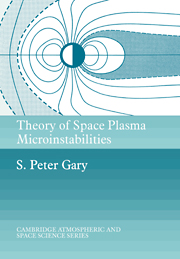Book contents
- Frontmatter
- Contents
- Preface
- 1 Introduction
- 2 Electrostatic waves in uniform plasmas
- 3 Electrostatic component/component instabilities in uniform plasmas
- 4 Electrostatic drift instabilities in inhomogeneous plasmas
- 5 Electromagnetic fluctuations in uniform plasmas
- 6 Electromagnetic waves in uniform plasmas
- 7 Electromagnetic temperature anisotropy instabilities in uniform plasmas
- 8 Electromagnetic component/component instabilities in uniform plasmas
- Appendix A The plasma dispersion function
- Appendix B Unperturbed orbits
- Appendix C Integral evaluation
- Index of symbols
- Index
8 - Electromagnetic component/component instabilities in uniform plasmas
Published online by Cambridge University Press: 06 November 2009
- Frontmatter
- Contents
- Preface
- 1 Introduction
- 2 Electrostatic waves in uniform plasmas
- 3 Electrostatic component/component instabilities in uniform plasmas
- 4 Electrostatic drift instabilities in inhomogeneous plasmas
- 5 Electromagnetic fluctuations in uniform plasmas
- 6 Electromagnetic waves in uniform plasmas
- 7 Electromagnetic temperature anisotropy instabilities in uniform plasmas
- 8 Electromagnetic component/component instabilities in uniform plasmas
- Appendix A The plasma dispersion function
- Appendix B Unperturbed orbits
- Appendix C Integral evaluation
- Index of symbols
- Index
Summary
In this chapter we continue to study electromagnetic fluctuations in homogeneous, magnetized, collisionless plasmas. The new element here is that we consider the zeroth-order distribution function of each plasma component to be Maxwellian with drift velocity v0j parallel or antiparallel to B0 (Equation (3.1.3)). If two components have a relative drift v0 greater than some threshold, the corresponding free energy can lead to instability growth. Section 8.1 outlines the derivation of the dispersion equation for this case; Section 8.2 discusses electromagnetic ion/ion instabilities; Section 8.3 addresses electromagnetic electron/electron instabilities; Section 8.4 considers electromagnetic electron/ion instabilities; and Section 8.5 examines the consequences of electromagnetic effects on ion/ion instabilities that are electrostatic in the limit of zero β. Section 8.6 is a brief summary.
Space plasma heating and acceleration processes typically act on both species and are likely to give rise to beam/core distributions for both electrons and ions. However, in contrast to the case of T⊥ j > T‖j discussed in the previous chapter, the instabilities driven by beam/core free energies do not clearly separate into low frequency ion-driven and high frequency electron-driven modes. Thus, although we treat relative ion drifts and relative electron drifts separately in this chapter, this separation is due more to our desire to clarify the presentation than to any compelling physical arguments. Thus, in Sections 8.2 through 8.5, we consider a two-species, three-component plasma consisting of a relatively tenuous beam (denoted by subscript b), a relatively dense core (c), and a third component of the other species.
- Type
- Chapter
- Information
- Theory of Space Plasma Microinstabilities , pp. 143 - 169Publisher: Cambridge University PressPrint publication year: 1993



